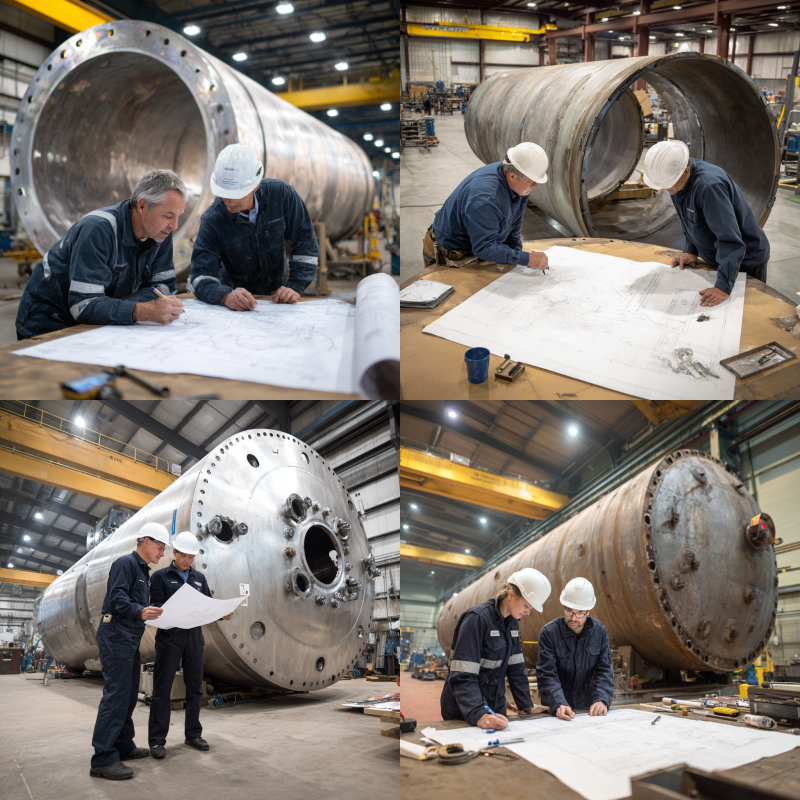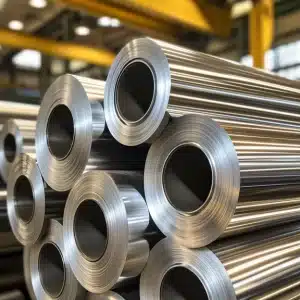
How Do ASME Codes Influence Pressure Vessel Design?
How Do ASME Codes Influence Pressure Vessel Design Across Industries
When engineers and manufacturers ask, how do ASME codes influence pressure vessel design, the answer lies in one word: safety. The American Society of Mechanical Engineers (ASME) has long established itself as the gold standard for pressure vessel fabrication, defining strict rules that govern materials, welding techniques, inspection procedures, and stress limitations. These codes aren’t optional—they’re foundational. At Red River, our capabilities revolve around ASME principles, ensuring clients receive pressure vessels that are safe, durable, and compliant.
What ASME Codes Actually Cover in Pressure Vessel Design
ASME Section VIII Division 1, one of the most commonly used codes, outlines the rules for the design, fabrication, and inspection of pressure vessels. It provides formulas for stress calculations, guidelines on material selection, and instructions for nondestructive examination (NDE). Without these standards, vessels would be exposed to inconsistent practices that could lead to failure. When Red River fabricates ASME-certified pressure vessels, it follows each code down to the smallest weld to ensure top-tier performance.
The Role of Design Pressure and Temperature in ASME Compliance
Design pressure and temperature dictate the thickness, shape, and reinforcement requirements of a vessel. ASME codes specify how to account for internal and external pressures, including conditions like wind and seismic activity. This directly affects how a vessel will respond under real-world conditions. During your quote request, our engineers consider environmental loads in line with ASME stipulations, making sure your equipment performs reliably under pressure.
How Material Selection is Guided by ASME Standards
Material choice isn’t just about cost or availability—it’s about compliance. ASME codes include a list of approved materials that are rigorously tested for mechanical properties like tensile strength, corrosion resistance, and ductility. Selecting from this list ensures that every vessel we build meets industry expectations. Whether you’re sourcing metal fabrications or full assemblies, Red River always uses ASME-listed materials.
Welding Methods and ASME Qualification Requirements
Welding is one of the most critical steps in vessel fabrication. ASME Section IX lays out the qualifications for welders and procedures, requiring documented performance tests and proven technique consistency. Each weld must be traceable to a qualified welder and a written procedure. Red River’s shop prioritizes quality by training our welders under these guidelines. You can see this commitment in all our pressure vessel projects.
Inspection and Testing: Code-Driven Quality Assurance
Another core aspect of answering how do ASME codes influence pressure vessel design is inspection. From radiography and hydrostatic testing to ultrasonic and magnetic particle testing, ASME defines how and when to perform these checks. Our fabrication processes follow these rules strictly to verify structural integrity and detect any flaws before delivery.
Understanding Allowable Stress and Wall Thickness
ASME codes use conservative estimates for allowable stress values. These ensure that vessels operate well below the point of material failure. The wall thickness, in particular, is calculated based on pressure, material strength, and corrosion allowances. Red River engineers use these formulas every day, ensuring our prefabricated spools and vessels meet all required standards from the ground up.
Flooring Samples vs. Pressure Vessel Samples: What’s the Common Link?
While it may seem strange to connect flooring samples with pressure vessels, they share a similar principle—testing before committing. Just as you examine flooring for color and fit, we run simulations and prototype testing for vessel performance. And just like a pulsation bottle must meet ASME pressure ratings, flooring must endure environmental and physical stress tests.
Risk Mitigation Through ASME Code Compliance
The primary goal of ASME compliance is to mitigate risk. Vessels that fail in the field can lead to environmental disasters, lost productivity, or worse—loss of life. By adhering to ASME’s design and manufacturing rules, Red River helps clients minimize operational hazards. Learn more about our safety-focused approach through our company overview.
ASME Codes and Their Global Impact on Vessel Design
ASME codes aren’t limited to the U.S.—they’re recognized worldwide. From the oil fields of Texas to petrochemical plants in Southeast Asia, these standards ensure consistent, safe equipment across borders. Red River’s commitment to code compliance makes us a trusted partner for international clients looking for American-made tanks.
Modularization and ASME-Compliant Skid Packages
Today’s industrial facilities want flexible, transportable systems—and modular skids deliver that. But just like standalone vessels, these skids must also comply with ASME rules. Red River’s modular skid systems integrate pressure vessels, piping, and instrumentation, all built to ASME specifications to ensure performance and legal compliance.
Code Stamping – What It Is and Why It Matters
A pressure vessel is not ASME-certified until it’s inspected and approved by an Authorized Inspector (AI). The vessel must pass all code requirements and receive an official ASME stamp (such as U or UM). This stamp is your proof of compliance and gives regulatory bodies confidence in the product’s integrity. See how Red River integrates stamping into its design workflow.
What Happens When Codes Aren’t Followed
Non-compliance leads to catastrophic results—code violations have caused plant shutdowns, massive fines, and tragic accidents. By understanding how do ASME codes influence pressure vessel design, clients can better appreciate the role of expert fabrication partners like Red River. Our dedication to compliance helps avoid mistakes like those outlined in our pressure vessel failure case studies.
Documentation and Traceability in Code-Compliant Projects
Every weld, material, and inspection is documented and traceable. ASME requires this level of accountability so that if problems arise, you can trace back every component. Our team provides full data reports for all jobs, giving clients peace of mind. Whether you’re reviewing shop drawings or scheduling delivery, our documentation practices support transparency and trust.
Training and Continuous Code Updates
ASME regularly updates its codes to reflect new research, materials, and methods. Red River invests in ongoing training for our design and fabrication teams to stay ahead of revisions. From webinars to certifications, our staff stays code-aware and future-ready. This commitment sets us apart as a forward-thinking employer in fabrication.
How Do ASME Codes Influence Pressure Vessel Design in Real-World Applications
Understanding how do ASME codes influence pressure vessel design is critical when choosing a manufacturing partner that values both safety and performance. These codes shape every phase of the process—from selecting materials and calculating stress limits to qualifying welds and verifying integrity through rigorous testing. At Red River, our entire approach is built on these foundational standards. Whether you’re developing new infrastructure or upgrading existing systems, you can trust our team to deliver vessels that meet ASME expectations and exceed client demands. Explore our pressure vessel services to see how we uphold code compliance with every build.
Need a reliable partner?
Red River specializes in the design and manufacturing of pressure vessels. We also fabricate related items such as prefabricated spools and skid packages.
Reach out to us today and experience the Red River difference. Where American-made products and American Values come together, we care more.
Frequently Asked Questions
1. How to design pressure vessel?
Pressure vessel design requires careful consideration of pressure ratings, temperature, material properties, and ASME code compliance. Learn more in our guide to vessel design.
2. How do ASME codes influence pressure vessel design?
ASME codes define every aspect of vessel design, including stress calculations, allowable materials, and inspection methods. Learn how Red River stays compliant through our fabrication blog.
3. What materials are commonly used in pressure vessel design?
Carbon steel, stainless steel, and chrome-moly alloys are popular ASME-approved materials. Learn how material choices affect performance in our engineering insights.
4. What is an ASME stamp?
It’s an official certification showing a vessel meets ASME code standards. Read more about the importance of ASME stamping on our certification process page.
5. Can I use non-ASME materials?
Using non-ASME materials puts your equipment at risk of failure and legal issues. Always source from trusted fabricators who follow ASME rules.
Key Takeaways
- ASME codes define the rules for pressure vessel design, materials, welding, and testing
- These codes ensure safety, legal compliance, and operational efficiency
- Red River strictly adheres to ASME requirements from concept to delivery
- Code compliance minimizes liability and extends equipment lifespan
- Global industries trust ASME standards, and Red River brings them to life with American expertise
Related Blog Post

Marine-Grade vs Standard Stainless Steel

Pros and Cons of Vertical Integration

How to Dry Desiccant Properly and Regain Its Effectiveness

Why Do Gas Turbines Need Fuel Water Separator Vessels, Red River

